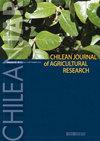芽孢杆菌属原生细菌对番茄根结线虫的拮抗作用
IF 1.5
4区 农林科学
Q2 AGRICULTURE, MULTIDISCIPLINARY
引用次数: 0
摘要
根结线虫(Meloidogyne spp.)造成高达68%的番茄(Solanum lycopersicum L.)产量损失,管理措施有限,主要使用有毒化学品。采用4种番茄种质,2种商品(敏感和耐药)和2种野生(IAC 1687和COLY 007),以芽孢杆菌属原生细菌对线虫的拮抗作用为基础,评价了综合管理方案。在体外培养阶段,对接种后9 d的婴儿双歧杆菌(GIBI 177)、高原双歧杆菌(GIBI 187)、矮头双歧杆菌(GIBI 195)、解淀粉双歧杆菌(GIBI 200)和矮头双歧杆菌(GIBI 206)进行线虫卵孵化抑制率和孵育后72 h的幼虫死亡率测定。结果表明,在控制条件下,所有本地菌株均有防虫效果,但选择指数最高的是婴儿双歧杆菌(0.65)。田间阶段,采用分区设计,以四番茄基因型为主区,芽孢杆菌菌株为次区,分别进行了严重程度百分率、虫卵数和幼虫数的评价。番茄基因型IAC 1687对Meloidogyne spp的侵染反应最好,达到2088.8 ±599.1个体100 g-1根。与4个基因型中3个基因型相互作用最好的细菌是短螺旋体(GIBI 206),在IAC 1687中为1731.33 ±1382。100 g-1根57株,抗性基因型为16627株±4588.1株,易感基因型为3303.83株±1256.25株。本研究报告了利用番茄遗传资源和拮抗菌作为根结线虫的潜在综合管理方法。本文章由计算机程序翻译,如有差异,请以英文原文为准。
Antagonist effect of native bacteria of the genus Bacillus on the root-knot nematode (Meloidogyne spp.) in tomato germplasm
The root-knot nematode (Meloidogyne spp.) causes losses of up to 68% of tomato (Solanum lycopersicum L.) production, management practices are limited and toxic chemicals are mostly used. An integrated management alternative was evaluated based on the antagonist effect of native bacteria of the genus Bacillus on the nematode using four tomato germplasms, two commercial (susceptible and tolerant) and two wild (IAC 1687 and COLY 007). In the in vitro phase, strains B. infantis (GIBI 177), B. altitudinis (GIBI 187), B. pumilus (GIBI 195), B. amyloliquefaciens (GIBI 200) and B. pumilus (GIBI 206) were evaluated and the percentage of inhibition of nematode egg hatching at 9 d after inoculation and the percentage of mortality in juveniles at 72 h after incubation were determined. The results showed that all native strains presented a control effect under controlled conditions, but B. infantis being the bacterium with the highest selection index (0.65). In the field phase, a split-plot design was established, the main plot being the four-tomato genotype and the secondary plot the bacillus strain, and the percentage of severity, number of eggs and juveniles were evaluated. The tomato genotype with the best response to Meloidogyne spp. attack was IAC 1687, when obtaining values of 2088.8 ± 599.1 individuals 100 g-1 root. The bacterium that presented the best interaction with 3 of the 4 genotypes evaluated was B. pumilus (GIBI 206), in IAC 1687 with 1731.33 ± 1382. 57 individuals 100 g-1 root, in the resistant genotype with 16627 ± 4588.1 individuals 100 g-1 root and in the susceptible genotype with 3303.83 ± 1256.25 individuals 100 g-1 root. This study reports the use of tomato genetic resources and antagonist bacteria as a potential integrated management of the root-knot nematode.
求助全文
通过发布文献求助,成功后即可免费获取论文全文。
去求助
来源期刊

Chilean Journal of Agricultural Research
AGRICULTURE, MULTIDISCIPLINARY-AGRONOMY
CiteScore
3.10
自引率
11.80%
发文量
60
审稿时长
6-12 weeks
期刊介绍:
ChileanJAR publishes original Research Articles, Scientific Notes and Reviews of agriculture, multidisciplinary and agronomy: plant production, plant protection, genetic resources and biotechnology, water management, soil sciences, environment, agricultural economics, and animal production (focused in ruminant feeding). The editorial process is a double-blind peer reviewing, Editorial Office checks format, composition, and completeness, which is a requirement to continue the editorial process. Editorial Committee and Reviewers evaluate relevance and scientific merit of manuscript.
 求助内容:
求助内容: 应助结果提醒方式:
应助结果提醒方式:


